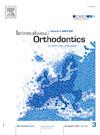Knoop microhardness, surface roughness, and cytotoxicity analysis of arginine-modified experimental orthodontic resins: An in vitro study
IF 1.9
Q2 DENTISTRY, ORAL SURGERY & MEDICINE
引用次数: 0
Abstract
Aim
The study aimed to evaluate the impact of incorporating 2.5%, 5%, and 7% arginine on the hardness, roughness, and cytotoxicity of 3M™ Transbond™ XT.
Material and methods
A total of 48 samples were divided into four groups (n = 12): G1 – commercial resin 3M™ Transbond™ XT (TXT); G2 – TXT + 2.5% arginine; G3 – TXT + 5% arginine; and G4 – TXT + 7% arginine. The hardness analysis was performed by a microhardness tester. The measurements of roughness were performed by a surface roughness measuring instrument. The surface morphology analysis was analyzed by digital images obtained with a scanning electron microscope (SEM). For the in vitro cytotoxicity test, dental pulp mesenchymal cells underwent a cell viability reduction assay. For statistical analysis, ANOVA (one-way/two-way) was used, followed by Tukey's test post hoc (P < 0.05).
Results
There was a reduction in the hardness of experimental resins compared to 3M™ Transbond™ XT commercial resin (P < 0.05). There was no difference between concentrations of 2.5% and 5%, but there was the largest reduction in resin with 7% arginine (P < 0.05). Surface roughness analysis showed there was no statistical difference between the samples (P ≥ 0.05). SEM also did not demonstrate changes in the surface roughness of the resins. All groups exhibited good cell viability at each timepoint. After 48h, an increase was observed for groups contaning arginine (P < 0.05).Conclusion: Surface hardness was modified with when arginine incorporation - to the Transbond™ XT resin formulation. No differences were observed for surface roughness. Due to the initial cytotoxicity of the resins, precautions regarding satisfactory photopolymerization and the distance of application in relation to the gingival tissues must be adopted.
精氨酸修饰实验正畸树脂的Knoop显微硬度、表面粗糙度和细胞毒性分析:一项体外研究
该研究旨在评估2.5%、5%和7%精氨酸对3M™Transbond™XT的硬度、粗糙度和细胞毒性的影响。材料和方法48份样品分为4组(n = 12): G1 -商用树脂3M™Transbond™XT (TXT);G2 - TXT + 2.5%精氨酸;G3 - TXT + 5%精氨酸;G4 - TXT + 7%精氨酸。硬度分析采用显微硬度计进行。采用表面粗糙度测量仪进行粗糙度测量。利用扫描电子显微镜(SEM)获得的数字图像对表面形貌进行分析。体外细胞毒性试验采用牙髓间充质细胞活力降低法。统计分析采用单因素方差分析(单/双向),随后采用Tukey’s事后检验(P <;0.05)。结果与3M™Transbond™XT商用树脂(P <;0.05)。2.5%和5%的浓度之间没有差异,但7%精氨酸的树脂减少幅度最大(P <;0.05)。表面粗糙度分析显示,两组间差异无统计学意义(P≥0.05)。扫描电镜也没有显示树脂表面粗糙度的变化。各组在各时间点均表现出良好的细胞活力。48h后,精氨酸(P <;0.05)。结论:当精氨酸掺入Transbond™XT树脂配方时,表面硬度得到了改善。表面粗糙度没有观察到差异。由于树脂的初始细胞毒性,必须采取关于满意的光聚合和与牙龈组织相关的应用距离的预防措施。
本文章由计算机程序翻译,如有差异,请以英文原文为准。
求助全文
约1分钟内获得全文
求助全文
来源期刊

International Orthodontics
DENTISTRY, ORAL SURGERY & MEDICINE-
CiteScore
2.50
自引率
13.30%
发文量
71
审稿时长
26 days
期刊介绍:
Une revue de référence dans le domaine de orthodontie et des disciplines frontières Your reference in dentofacial orthopedics International Orthodontics adresse aux orthodontistes, aux dentistes, aux stomatologistes, aux chirurgiens maxillo-faciaux et aux plasticiens de la face, ainsi quà leurs assistant(e)s. International Orthodontics is addressed to orthodontists, dentists, stomatologists, maxillofacial surgeons and facial plastic surgeons, as well as their assistants.
 求助内容:
求助内容: 应助结果提醒方式:
应助结果提醒方式:


